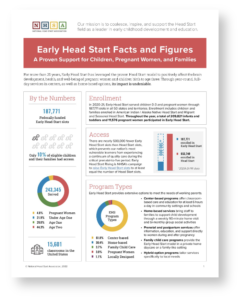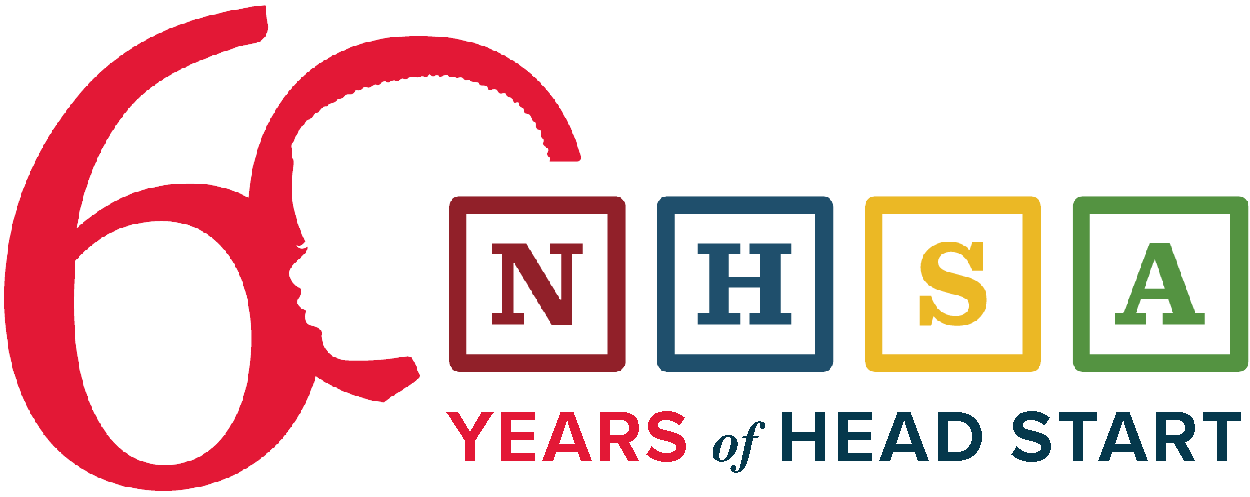A key part of building buy-in among stakeholders is helping them understand what Early Head Start is, the support it provides to infants, toddlers, and families, and the impact it has. The FAQs below work to answer many of these key, common questions. They can be printed and shared directly, posted on your website, or used in your conversations as you advocate for your program and the families you serve!
What is Early Head Start?
Early Head Start is the only federal program focused on prenatal to age three early development and learning for families from income-eligible households, with a proven impact on the lives of infants and toddlers and their families.
Who does Early Head Start support?
Early Head Start works with pregnant families and children from income-eligible households during the most crucial years in a child’s development—prenatal to age three. Eligible infants, toddlers, and families include those whose incomes are below the Federal Poverty Line, children in foster care, and children experiencing homelessness.
What types of support does Early Head Start provide?
Early Head Start provides comprehensive, wraparound support, such as home visiting, health screenings, enriching childcare, and parental skill-building and education, to pregnant families and children from income-eligible households. There are three key areas of Early Head Start’s support: child care, health support for children, and prenatal, pregnancy, and postpartum support for families.
- Child care
Early Head Start provides extensive, quality child care options to meet the needs of working parents. Through home-based child care and center-based spots, Early Head Start providers and educators offer quality, research-based care for working families. Ninety-four% of center-based slots are offered five days a week for more than six hours per day. - Health support for children
Early Head Start ensures that young children, from prenatal through age three, have quality health care. This includes providing health insurance and medical home assistance, dental health support, and access to regular immunizations. - Support for pregnant women and families
Early Head Start offers critical support that gives parents and families the skills to build a strong foundation for their young children’s future. Such support includes: parenting education, health education, housing assistance, job training, substance abuse prevention, and domestic violence prevention.
 How many children and families does Early Head Start support?
How many children and families does Early Head Start support?
There are currently 166,693 Early Head Start spots available to infants and toddlers age zero to three and pregnant families across all 50 states. Since its inception, Early Head Start has helped support millions of infants, toddlers, and families across the country.
Are there proven benefits for children who have received Early Head Start support?
When parents and families with children prenatal to three can access the support they need, they strengthen their parenting skills and their bond with their children. By ensuring young children have what they need during those first years, we create a strong foundation for their future. Research shows:
-
- children in Early Head Start develop new social-emotional skills and sustain the positive impacts through at least fifth grade.
- children also make gains in language and cognitive development.
- families and children who had received Early Head Start services are significantly less likely to be reported to child welfare agencies—a measure of child abuse or neglect—than children and families not in the program.
- parents who participate in Early Head Start improve their parenting skills.
- fathers who participate in Early Head Start are more engaged in their children’s lives.
Are there proven benefits for families who have received Early Head Start support?
Research shows that Early Head Start mothers who enroll during pregnancy are better able to emotionally support their children and fathers who participate in Early Head Start are more engaged in their children’s lives. These outcomes lead to improved social-emotional health and cognitive development in their young children. Investing money to lift kids out of poverty, especially infants and toddlers, has enormous lifelong benefits, including improved academic performance and better health.
What impact does Early Head Start have on communities?
Early Head Start builds communities of care and fosters cross-sector collaborations in communities across the country. Through Early Head Start-Child Care Partnerships, Early Head Start programs have partnered with over 1,400 child care centers and 1,000 in-home child care providers to provide 38,000 infants and toddlers and their families quality wraparound support.
How does Early Head Start differ from Head Start?
Early Head Start and Head Start both provide comprehensive, wraparound support for families and children from income-eligible households. But while Early Head Start provides support that addresses prenatal to age three, Head Start support focuses on age three to age five.
Another key difference between Head Start and Early Head Start is access. There are approximately four times fewer Early Head Start spots than Head Start spots, with 166,693 children and families enrolled in Early Head Start and 675,734 children and families enrolled in Head Start each year.
What standards does Early Head Start use to ensure a quality care experience for children and families?
Early Head Start services follow the Head Start Program Performance Standards, which reflect the best practices and latest research on early childhood development and brain science. These standards serve as the foundation for Early Head Start’s support for income-eligible infants, toddlers, and families. In addition to the foundational Head Start Program Performance Standards, Early Head Start child care teachers are required to have a minimum of a Child Development Associate credential and training with a focus on infant and toddler development. Health support services must reflect the requirements of Early and Periodic Screening, Diagnosis, and Treatment (EPSDT) in their state, in addition to the Head Start Performance Standards related to Health, Nutrition, Mental Health, and Safety.
Is Early Head Start a part of the national Head Start program?
Early Head Start is housed under the federal Office of Head Start. While Early Head Start provides support that addresses prenatal to age three, Head Start support focuses on age three to age five.
Who provides these support services to children and families?
Head Start programs deliver services through 1,600 agencies in local communities. Most Head Start programs are run by nonprofit organizations, schools, and community action agencies. They provide services to more than a million children every year, in every U.S. state and territory.
Has the COVID-19 pandemic impacted Early Head Start and its support offerings?
Prior to the pandemic, Early Head Start only reached 11% of eligible young children and their families. While many child care facilities and support services closed, Early Head Start continued to serve families. Because of COVID-19, even more children and their families have fallen behind and are in need of Early Head Start support.
When was Early Head Start founded?
In 1995, the federal Early Head Start program was created to give all young children the same opportunities to succeed. Young children living in poverty are more likely to face challenges that negatively impact their development.
Why does Early Head Start need additional funding?
Only one in 10 income-eligible infants and families have access to Early Head Start support because of insufficient funding. Increasing funding is a necessary first step to ensure all families have access to the crucial support and services they need during their child’s earliest years. It’s a good investment, too. For every dollar spent on early childhood education, the return is between $4 and $9.
Related Content
